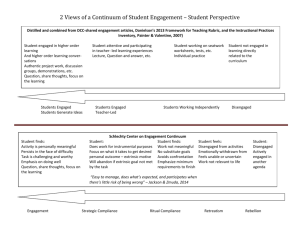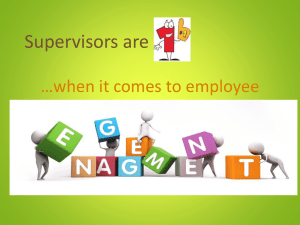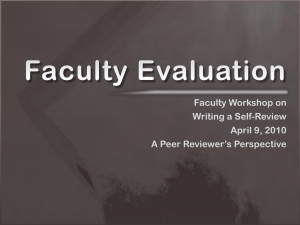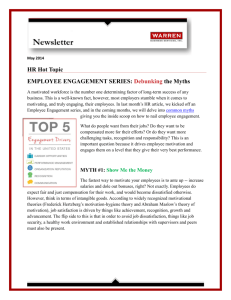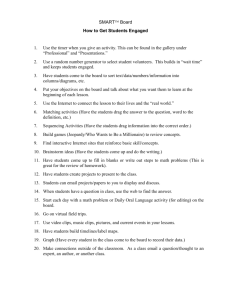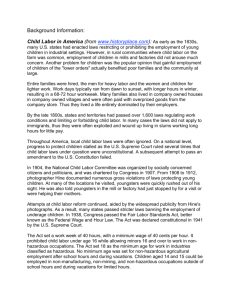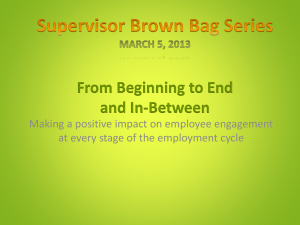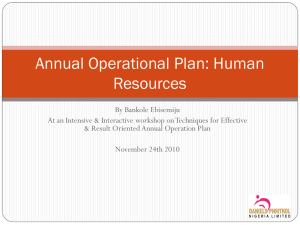Employee Engagement - IPMA-HR
advertisement
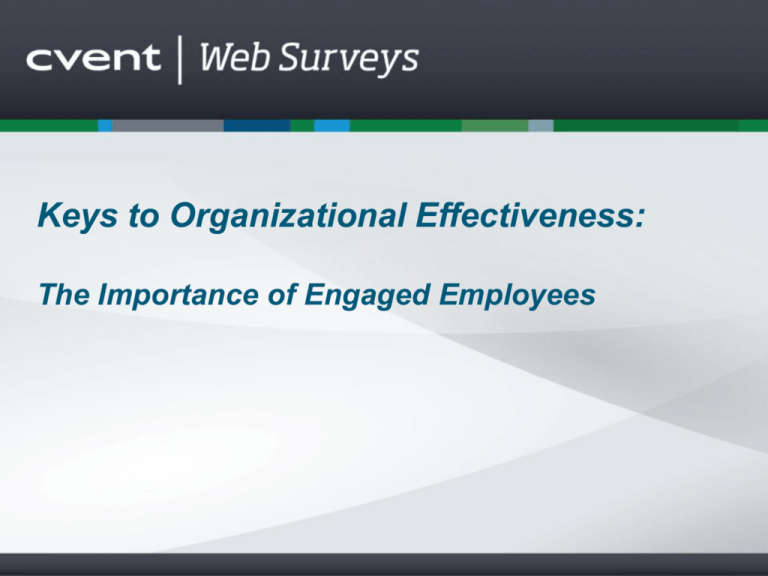
Keys to Organizational Effectiveness: The Importance of Engaged Employees Your Speaker Today Mike Phillips Director of Feedback Strategy Cvent Web Surveys mphillips@cvent.com Employee “Engagement” Defined Employee Engagement Study, July 2012 An engaged employee is enthusiastically and proudly involved in his or her organization and day-to-day job responsibilities, and engagement keeps employees committed to their work. “A heightened emotional connection that an employee feels for his or her organization, that influences him or her to exert greater discretionary effort to his or her work.” - The Conference Board “The measurable degree of an employee’s positive or negative emotional attachment to their job, colleagues and organization that profoundly influences their willingness to learn and perform at work.” Why is Engagement Important? Engagement Benchmarks “Only 58% of public sector employees are fully engaged in their jobs.” “Depending on global region, industry type and company size, an average of 29% 33% of employees can be considered at any particular point in time.” Engaged public sector employees are… ► Twice as likely to stay in their current job ► 2.5 times more likely to feel they can “make a difference” ► 2.5 times more likely to recommend their workplace to others ► Three times as likely to report being “very satisfied” in their jobs Why is Engagement Important? Revenue: engaged employees play a major role in helping achieve revenue goals. Employee retention: engaged workforces enjoy higher retention rates. Productivity: engaged employees are more productive. Morale: engaged employees have higher morale. Creativity: engaged employees are viewed as more creative and innovative. Stakeholder loyalty: engaged employees are key to creating more loyal stakeholders. Getting to “Engagement” Employee Engagement – First Principles Leadership Emphasis on Employee Engagement 100% 81% 80% 60% 40% 36% 33% 31% 20% 13% 7% 0% Low Average <50% High >50% Source: Employee Engagement Benchmark Study Demand Metric Research Corporation December, 2013 Measuring Engagement “How do you measure effects of employee engagement?” 45% Customer sat scores 32% 31% "Hygiene" metrics 17% 35% Productivity metrics 19% 55% Employee survey 45% 6% 5% Other 18% None 35% 0% 10% 20% Engagement >50% 30% 40% 50% 60% Engagement < 50% Source: Employee Engagement Benchmark Study Demand Metric Research Corporation December, 2013 Creating an Engaged Culture “How do you create and maintain engagement?” Performance reviews 70% Skill training 63% Recognition programs 59% Team building 54% Feedback programs 52% Internal communications 43% Supervisory training 36% Service training 29% Other 8% None 6% 0% 10% 20% 30% 40% 50% 60% 70% 80% Source: Employee Engagement Benchmark Study Demand Metric Research Corporation December, 2013 Key First Steps Measure Engagement Levels What are the components of engagement? How do my levels compare to others’ levels? How does engagement differ by division, department, region, management level, etc…? Assess Factors Driving Engagement How do the drivers of engagement differ across various units and levels? Are current programs focused on engagement or something less? Take Action! Recognize and reward engagement (share stories, recognize good work, reinforce positives) Remediate areas of disengagement (create clarity, revise messaging, re-focus training) Current State of Measurement “Do You Have A Formal Employee Survey?” Not Sure - 3% Yes - 30% No - 67% “In spite of the importance of employee retention to agency success, more than two-thirds of those surveyed do not have a formal process, such as employee opinion surveys or other research tools, for assessing employee engagement.” Employee Engagement Study, July 2012 11 Quantifying and Acting on Engagement 2 Key Dimensions to Engagement Alignment Engagement Empowerment Engagement Segmentation Alignment Questions: 1. I know what is expected of me at work. 2. The 3. My 4. I mission/purpose of my company makes me feel my job is important. associates (fellow employees) are committed to doing quality work. have a best friend at work. 5. In the last six months, someone at work has talked to me about my progress. Empowerment Questions: 6. I have the materials and equipment needed to perform my duties. 7. I have the opportunity to do what I do best every day. 8. In the last seven days, I have received recognition or praise for doing good work. 9. My supervisor cares about me as a person. 10.Someone at work encourages my development. 11.At work, my opinions seem to count. 12.In the last year, I have had opportunities to learn and grow. Engagement Segmentation Step 1: ENGAGED • • MAKE DECISIONS AND TAKE ACTIONS PRODUCTIVE CONTRIBUTORS DO NOT USE THEIR OWN JUDGMENT OR MAKE THEIR OWN THAT THEY BELIEVE ARE IN THE BEST INTERESTS OF THE COMPANY DECISIONS ALIGNED Based on agreement w/each of the 12 Engagement Statements, each Employee can be segmented into Engaged or Disengaged segments based on agreement with specific statements. ALIGNED DISENGAGED • NO CONNECTION W/ORGANIZATION • SOURCE OF INCOME ONLY EMPOWERED • FEEL FREE TO MAKE • DECISIONS DO NOT FEEL RESPONSIBLE FOR SUCCESS OF FIRM EMPOWERED THEIR OWN Engagement Segmentation Step 2: Predictive statistical analysis can then be performed to determine what attributes of the experience best predict differences between Engaged and Disengaged segments. ENGAGED DISENGAGED • • NO CONNECTION W/ORGANIZATION SOURCE OF INCOME ONLY MAKE DECISIONS AND TAKE ACTIONS Experience Attributes Defining the Difference THAT THEY BELIEVE ARE IN THE BEST INTERESTS OF THE ORGANIZATION. Employee Engagement Segmentation Basic Profile: Key Metrics “Engaged” Employee Segment Profile Employee Engagement Segments Engaged Empowered Aligned Disengaged Attribute •Satisfaction •Recommend •Aligned w/Mission •Empowered to Act Index →164 →152 →168 →181 Agreement Index (Top Box) My supervisor is a positive influence on me. 132 My supervisor provides regular feedback on performance 122 Attribute •Satisfaction •Recommend •Aligned w/Mission •Empowered to Act Index →121 →133 →124 →166 I am free to solve customer problems at my discretion. Work environment is professional. 89 Attribute •Satisfaction •Recommend •Aligned w/Mission •Empowered to Act Index →112 →131 →157 →131 I have the tools needed to do my job well. 88 Attribute Index •Satisfaction →89 •Recommend →77 •Aligned w/Mission →65 •Empowered to Act →58 113 The mission of the firm is well communicated. 93 My group works well as a team. 78 The benefits offered are better than those in other firms. 77 Members of my team communicate well with each other. 68 Training is a high priority within the 60 firm. 50 70 90 Below Average Agreement 110 130 150 Above Average Agreement Index: Index of 100 = average for all respondents Employee Engagement Segmentation Demographic Profile Report Example Employee Demographic Profile by Engagement Segment Demographic Profile by Employee Engagement Segment 170 Above Average 145 138 127 120 117 110 95 70 112 114 113 92 74 72 Below Average 63 53 34 20 Dept: IT Employment Tenure: 1 - 3 yrs Engaged Empowered 36 Dept: Case Management Aligned Level: Non-Supervisory Disengaged Index: Index of 100 = average for all respondents Employee Engagement Segmentation Key Driver Analysis of Engagement Primary Key Drivers of Employee Engagement Supervision 42% Problem Resolution 32% Training 26% 0% 5% 10% 15% 20% 25% 30% 35% % Importance in Predicting Employee Engagement 40% 45% Employee Engagement Segmentation Key Driver Analysis of Engagement Key Primary/Sub-Drivers of Employee Engagement Attribute Importance Supervision 42% Supervisor is a Positive Influence 22% Regular Feedback on Performance 20% Problem Resolution 32% Feel Free to Solve Customer Problems 17% Have Tools Needed to Do Job 15% Training 26% Training is High Priority 26% Full Circle Employee Engagement and Organizational Effectiveness Committed Ambassadors Higher Retention New Service Ideas Engaged Employees Great Stakeholder Experience Prouder Employees Loyalty Strong Performance Results Empowered Problem Solvers Investment in Employees Source: Temkin Group Thank you Mike Phillips mphillips@cvent.com 571-830-2149
